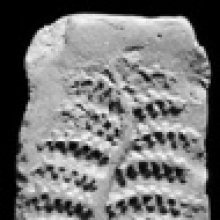Harappa: 3 definitions
Introduction:
Harappa means something in the history of ancient India. If you want to know the exact meaning, history, etymology or English translation of this term then check out the descriptions on this page. Add your comment or reference to a book if you want to contribute to this summary article.
Images (photo gallery)
India history and geography
Source: Knowledge Traditions & Practices of India: Architecture (1): Early and Classical Architecture (h)Harappa and Harappan civilization.—Excavations at Harappa and Mohenjo-daro in 1921-22 marked the discovery of the Indus or Harappan civilization (2600–1900 BCE). Later discoveries include major sites like Kalibangan (Rajasthan), Lothal (Gujarat) and, in the last two decades, Dholavira (Gujarat), Bhirrana, Rakhigarhi and Farmana (all three in Haryana). To date, over 1,100 urban and rural Harappan settlements have been found in the northwest of the Indian subcontinent.
Source: Knowledge Traditions & Practices of India: Other Technologies: A SurveyHarappan civilization.—One mainstay of the Indus or Harappan civilization (2600–1900 BCE for its urban or “Mature” phase) was agriculture. Along with it, ceramic technology developed and produced fine fired bricks as well as well as pots, which are required to carry water, store seeds and grain, and of course food.
India’s love for bangles is traceable to the Harappans’ manufacture of large numbers of gold, bronze, conch-shell, glazed faience or humble terracotta bangles. Weavers used wheel-spun thread and, besides widely used cotton, evidence of silk has recently come to light at two sites. Other crafts included stone and ivory carving, carpet making and inlaid woodwork.
Source: Shodhganga: Elements of Art and Architecture in the Trtiyakhanda of the Visnudharmottarapurana (history)Harappa refers to a certain period in the history of Indian Art.—The chronological order of the development of Indian Art as stated in The Heritage of Indian Art is as follows—[...] 1. Harappa and Mohenjo-Daro are the chief centers of Indus valley Art and culture and these two civilizations belong to 3000-2250 B.C. The people of the Indus valley civilization seems to be very creative in the arts of house-building, stone and clay statuary, bronze casting, making of ornaments of gold and silver, ivory carving, weaving etc.

The history of India traces the identification of countries, villages, towns and other regions of India, as well as mythology, zoology, royal dynasties, rulers, tribes, local festivities and traditions and regional languages. Ancient India enjoyed religious freedom and encourages the path of Dharma, a concept common to Buddhism, Hinduism, and Jainism.
See also (Relevant definitions)
Full-text: Indus Valley, Mohenjo-daro, Lothal, Kalibangan, Rakhigarhi, Bhirrana, Farmana, Linga, Vastushastra, Dholavira, Indian Art, Kshetra.
Relevant text
Search found 22 books and stories containing Harappa; (plurals include: Harappas). You can also click to the full overview containing English textual excerpts. Below are direct links for the most relevant articles:
Complete works of Swami Abhedananda (by Swami Prajnanananda)
Appendix 1 - Prehistoric Indus Civilization < [Discourse 1 - India and Her People]
Appendix 2 - Indian Art in all its Phases < [Discourse 1 - India and Her People]
Lord Jhulelal: An Analytical Study (by Thakkar Harish Gopalji)
Part 14 - Ancient Sindh and Sindhi People < [Chapter 2 - Literature Review]
Part 15 - Advancement in Civil Engineering < [Chapter 2 - Literature Review]
Vastu-shastra (1): Canons of Architecture (by D. N. Shukla)
(i) Origin of Indian architecture < [Chapter 4 - An outline History of Hindu Architecture]
(viii) Conclusion < [Chapter 5 - Study of Hindu Science of Architecture]
Kashyapa Shilpa-shastra (study) (by K. Vidyuta)
Introduction < [Chapter 1 - Introduction]
The Religion and Philosophy of Tevaram (Thevaram) (by M. A. Dorai Rangaswamy)
Chapter 4.6 - (f) Symbology of Trisula (the trident) < [Volume 2 - Nampi Arurar and Mythology]
Chapter 1.4 - Rishabharudha-murti (depiction of the Brahmani bull) < [Volume 2 - Nampi Arurar and Mythology]
Chapter 4.2 - Dakshinamurti < [Volume 2 - Nampi Arurar and Mythology]
Impact of Vedic Culture on Society (by Kaushik Acharya)
Related products



